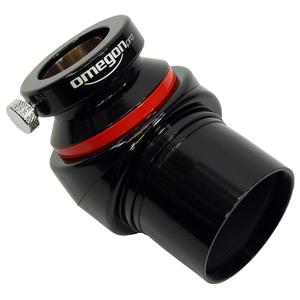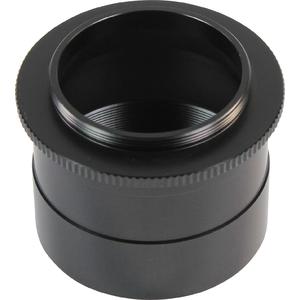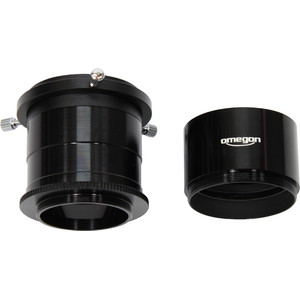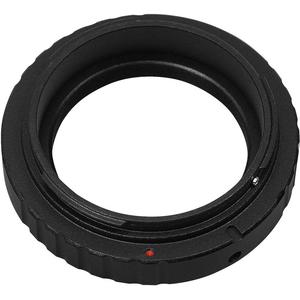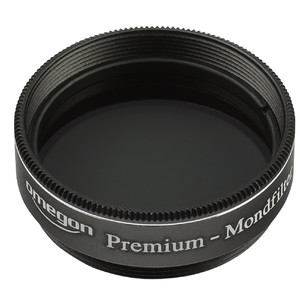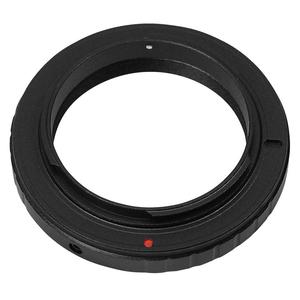Omegon Photoscope - The combination of telescope, spotting scope and lens
Telescopes and spotting scopes – both instruments are suitable for different purposes. Telescopes are used for astronomical observation and spotting scopes for nature observation. There are also telephoto lenses that allow you to capture your subjects in pictures. But what if there was an instrument that combined all three? The search is over: the Omegon Photoscope is here.
Nature looks absolutely brilliant: thanks to apochromatic optics
The coating on the lens surfaces shimmers in a delicate green. This is the visible sign of high-contrast images. A Doublet ED lens element delivers a clear and brilliant image. ED stands for "Extra Low Dispersion". This means that the scenes you observe are always crystal clear.
Observe nature, birds, mountains or the starry sky with impressive sharpness. The greenfinch will not just appear "green" to you; you will see variations from olive green to beige to sulphur yellow.
Your Omegon Photoscope is very versatile:
The telescope
Use the optics as a compact travel telescope. Observe the moon, star clusters or imagine how the great comet ISON floats across the field of view. Another advantage of this telescope: with one handle, you can mount the Photoscope on a tripod or an astronomical mount.
The spotting scope
During the day, the Photoscope simply becomes a spotting scope for your nature observations. For example, attach an Amici prism with a 45° viewing angle and then observe in complete relaxation – for hours on end, if you wish. Unlike other spotting scopes, the Photoscope can be combined with all kinds of accessories.
The lens
Capture nature with your camera. The Photoscope becomes a telephoto lens with a focal length of 432 mm when combined with an SLR camera. Digiscoping becomes child's play.
Quick Focus: quickly find the right focus
A central rotating ring allows you to quickly and easily set the optimum focus. Even with clammy hands, you will always find the focus point quickly, as the non-slip rubber armouring gives you a firm grip.
Whether you are observing stars in the far distance, deer at the edge of the forest or our feathered friends in your garden, you can focus perfectly on objects just a few metres away or at a great distance.
An additional fine focus ring allows you to find the nuances you need for perfect sharpness. This is particularly useful at higher magnifications or when taking photographs.
Accessories of your choice: the 2" connection
The Photoscope has a 2" connection, as is standard for astronomical telescopes. This allows you to choose from countless accessories. Would you prefer a 45° prism or a diagonal mirror? Do you value an eyepiece with a fixed focal length or a very special zoom eyepiece? You don't even have to stick with the same manufacturer. Simply choose what you want, because you have complete freedom when it comes to choosing accessories.
Sturdy transport case
A spotting scope is made for outdoor use, so to ensure that it can withstand any adventure, it comes in a sturdy transport case.
The case is lined with foam padding. The Photoscope is always optimally protected inside – even slight impacts during transport cannot damage it.
Advantages at a glance:
- Versatile: telescope, spotting scope and photo lens in one instrument
- Apochromatic optics: extremely sharp and high-contrast images right to the edge
- Lightning-fast focusing: large focus ring with "Quick Focus" mechanism
- Fine focus for perfect sharpness
- Well protected: internal focusing
- Small, compact travel telescope with 72 mm aperture
- With an Amici prism, it becomes a high-end spotting scope
- Super telephoto: Can be used as a photo lens with a focal length of 432 mm
- Fits any photo tripod: 1/4" photo thread connection
- Includes transport case with foam lining
- Lens type: FPL 51
Our expert comment:
A field-flattener is additionally needed for astrophotography with a DSLR. The Omegon Field-Flattener and, in addition, a 15mm extension tube plus a
T-2 adapter are required.
(Bernd Gährken)
Test report by Thomas Gade:
http://www.photoinfos.com/astronomie/Omegon-photography-scope-72-432-ed.htm
You can find an overview of the various Omegon apochromats in our buying guide in the online magazine.
To focus an SLR equipped with a T2 ring and a T-adapter (such as model no. 4573), you will need to insert an extension tube between this unit and the PhotoScope :
TS Optics Extension tube 35mm 2"
This will enable you to focus at distances below infinity.
This means that you can also photograph "natural" subjects at distances of a few dozen metres, and not just celestial objects.
(Sandra Eguay)
Please note that the optical draw of this instrument ("backfocus") varies between:
- 80 mm (+/- 1 mm) in the shortest possible focus position (6 m position)
- 126 mm (+/- 1 mm) in the longest possible focus position (position +8, i.e. infinity - the plane on which astronomical objects are located)
These measurements were taken by aiming at the same object at infinity (full moon).
For nearby objects, the Photoscope's behaviour will vary depending on the distance between the object and the observer.
